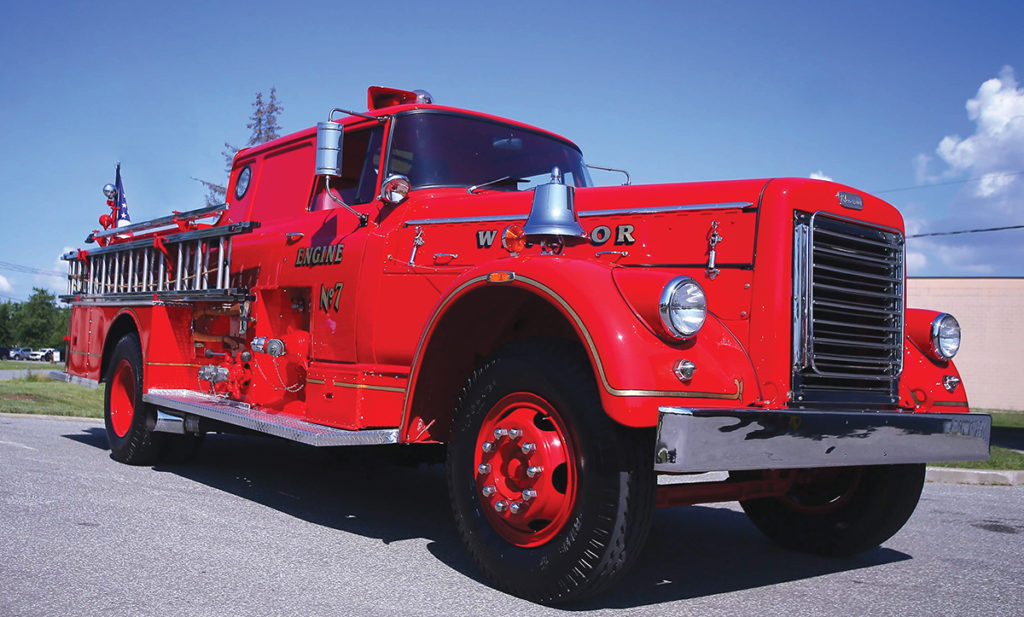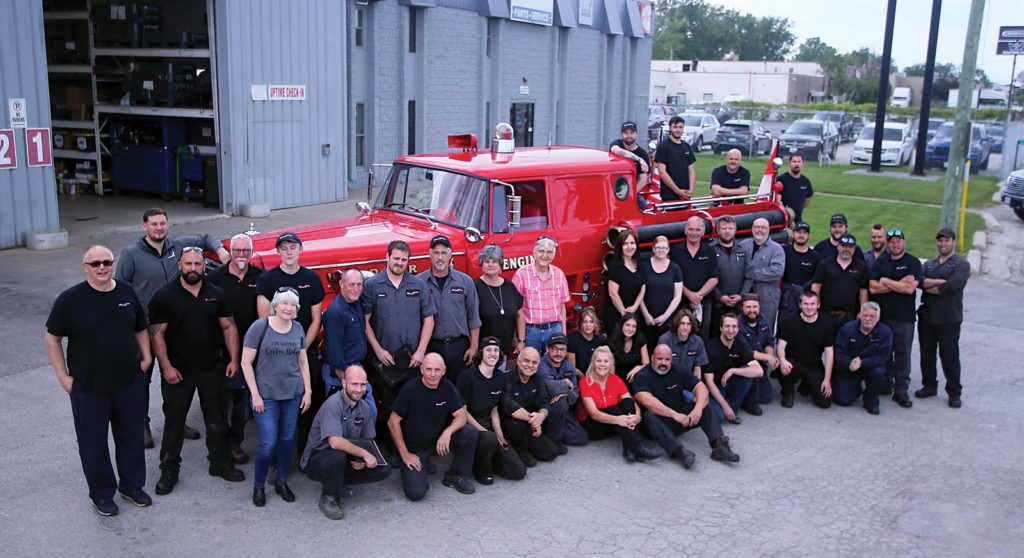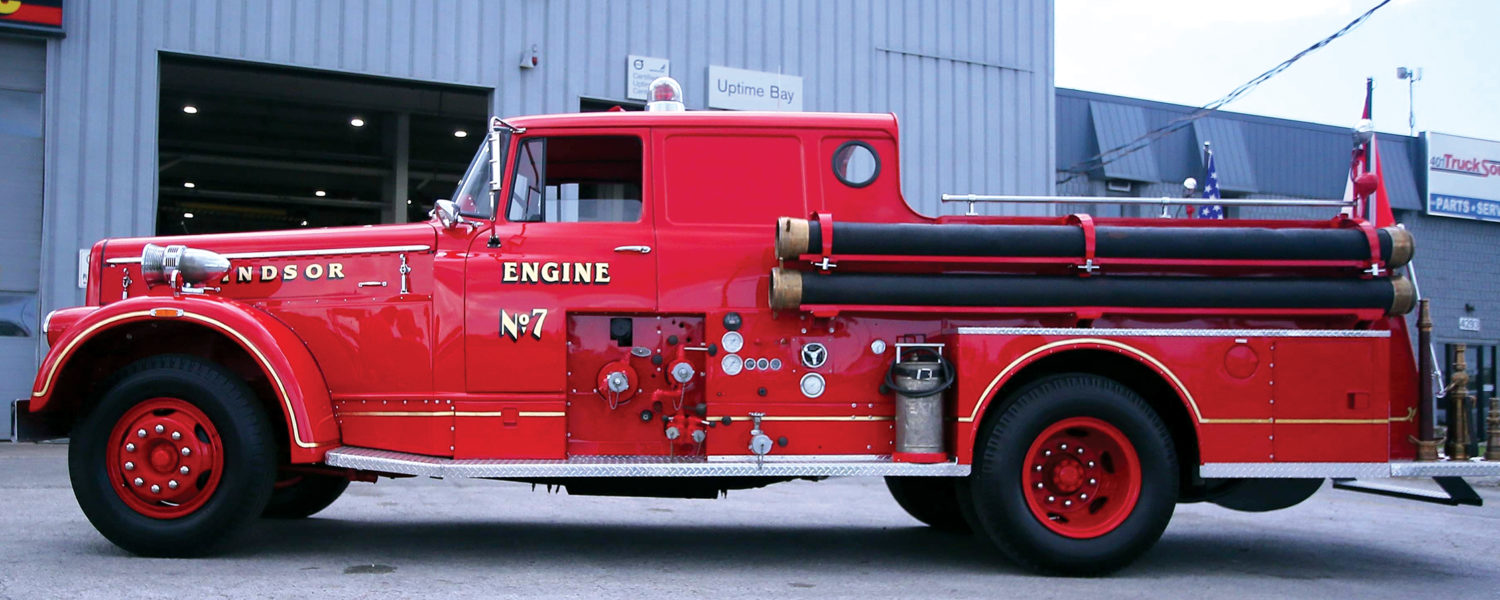An Irreplaceable Piece of Windsor
Fire Fighting History Was Rescued
From The Scrap Heap
Story by Matthew St. Amand
Photography by John Barnes
History matters. That is certainly what vice-president of the Windsor Professional Fire Fighter’s Association (WPFFA)—and thirty-year fire fighter—Wayne Currie, believes: “History helps us appreciate what we have today. We believe in preserving our history and having it for the future. Generations from now, people will look back and still have a fire truck that works”
The WPFFA have just completed a five-year odyssey restoring a vintage fire truck with the help of 401 Truck Source.
Today’s fire trucks are outfitted with an array of safety features, as well as high tech extraction equipment. Back in its day, fire fighters hung off the back of Engine No. 7—otherwise known as the “Elcombe” after the plant where it was refurbished in 1959—as it raced to fire scenes. The Elcombe’s equipment amounted to a length of hose and two axes.
“The life of this particular truck began in May 1927, when Walkerville Fire Chief Hedley G. Coates signed a purchase order for the Walkerville Fire Department’s first motor-driven pumper,” Wayne explains. “Over the years, this pumper underwent a number of refurbishments, with the biggest done in the late 1950s by Sandwich-based Elcombe Engineering Ltd.”

The Windsor Fire & Rescue Services website picks up the story from there: “In 1958, Engine No. 7 was delivered to the Elcombe factory on Russell St., near the foot of Mill Street. The 31-year-old pumper was stripped down to its bare frame. A modern canopy style cab and body which utilized some International Harvester truck body panels was designed and built. An Elcombe script nameplate was affixed to the top of the handsome new radiator grille. Now barely recognizable as its former self, the ‘born-again’ Engine No. 7 was placed back in service at Station 5 in mid-1959.”
The WPFFA membership thought the most recent refurbishment was so important that they voted to fund this project, which cost approximately $150,000.
“We assessed all of our members and took money from everyone’s pay to fund this project,” Wayne says. “We did this, also, for the monument down at the river that honours fire fighters who have died. That’s who rides on this truck. It is reserved for the people who pay the ultimate price.”
Over the course of Windsor Fire & Rescue Services’ history, thirty-one fire fighters have died in the line of duty or as a result of work-related injuries/illnesses.
How did Engine No. 7 come to need such tender loving care?
“The truck was coming back from a fire truck show in Chatham,” Wayne explains, “and one of the rods went through the engine block, destroying the engine. That was in 2016. We could not find a replacement engine. Even trying to find parts was difficult. The City of Windsor had maintained the truck for parades and as the official funeral truck. The City determined that it wasn’t economically feasible to repair the vehicle after the engine damage. We didn’t see it that way.”
The WPFFA expressed interest in taking possession of the truck, buying it from the City of Windsor at scrap metal cost. That was the easy part. Finding an outfit to undertake such a complex retool was another story.
“There are places around North America that do this, even one in Hamilton,” Wayne says. “We wanted a local company to handle the job, just as the fire chief did in 1958 going to Elcombe. That’s why we turned to 401 Truck Source. After meeting with the ownership and hearing their ideas about how they’d complete the project we had confidence they could do the job. More than that, they understood what this meant to us.”
With the fire fighters funding the restoration project, every means of cost savings was pursued. Local suppliers offered better pricing, in some cases donating parts and helping with labour costs.
“Everyone became a part of this project,” Wayne notes. “401 Truck Source, their hands, their workmanship are part of this. Engine No. 7 is a gem. It’s a one of a kind. It’s history on wheels. The chassis and hard suction screen are from the original 1927 truck.”

Wayne continues: “So many of our retirees say, ‘That was the truck we all got broken in on!’ This project has touched so many different people. It really brings back a flood of memories.”
The truck began life almost a century ago. Its chassis was made in the Gotfredson Truck Corporation plant on Walker Road a few blocks up the street from the Walkerville Fire Hall. Interestingly enough, the former Gotfredson factory was destroyed in a spectacular fire on June 30, 1985.
Following its 1958 refurbishment, the truck was still in service in late July 1967 when riots broke out in the Detroit. The Detroit Fire Department put out a call for assistance to help with the massive number of fires set throughout the city.
“The Windsor fire fighters taped the windows so they wouldn’t shatter if they were shot by snipers,” Wayne explains. “This truck battled fires all over the city, sharing hydrants with engines from fire departments from as far way as Toledo, Ohio.”
The truck was pumping when Windsor fire fighter, Len Bondy, lost his life during a blaze in 1971.
“Seeing this project start and finish during my watch was incredible,” says Wayne. “We were a small committee, ultimately just two of us working on this—people retired along the way and we didn’t replace them. We have voted that the WPFFA retain money in the budget to maintain this truck.”
Windsor residents will see Engine No. 7 in parades and large community events, such as FIREFEST 2023.
“We snuck it into the Canada Day parade,” Wayne says. “We needed to get that truck back to what it used to be. People will love seeing that truck, experiencing it. Our next project is a 1947 Mercury ambulance. We want to do our bit to preserve our history.”
Learn more about Engine No. 7 and other fascinating Windsor fire fighting history at windsorfire.com.




Add comment